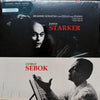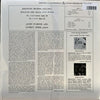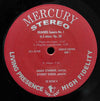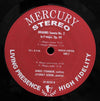







Johannes Brahms – Cello And Piano Sonatas - Janos Starker, Gyorgy Sebok
RARITY - Sealed
Johannes Brahms - Cello and Piano Sonatas No. 1 in e minor, Op. 38 & No. 2 in F, Opus 99
Cello - Janos Starker
Piano - Gyorgy Sebok
1LP, standard sleeve
Original Master Tape : YES
Heavy Press : 180g
Record color : black
Speed : 33RPM
Size : 12”
Stereo
Studio
Record Press : Pallas
Label : Speakers Corner
Original Label : Mercury
Recorded on June 25-26, 1964 at Watford Town Hall, outside London
Engineered by Robert Eberenz
Produced Harold Lawrence
Liner Notes by Frederic V. Grunfeld
Photography by Mary Morris
Originally released in 1965
Reissued in February 2007
Tracks :
Side A: Cello and Piano Sonatas No. 1 in e minor, Op. 38
1. Allegro non troppo
2. Allegretto quasi Minuetto
3. Allegro
Side B: Cello and Piano Sonatas No. 2 in F, Opus 99
1. Allegro vivace
2. Adagio affetuoso
3. Allegro passionato
4. Allegro molto
Reviews :
"It is not well known that Brahms, in his youth, achieved considerable skill on the cello. In 1895 he told the celebrated cellist Julius Klengel: “You ought to know that we are close colleagues. As a boy I also played the cello and even got as far as a Romberg concerto.” His E minor Cello Sonata, written in the early 1860s, was the first of his sonatas for piano and another instrument to survive his critical judgment; he had already composed and destroyed several violin sonatas. His F major Cello Sonata was composed more than twenty years later alongside the last two violin sonatas and the C minor Piano Trio. The cello parts of both sonatas demonstrate his intimate understanding of the instrument, and his piano parts, of course, reflect his own distinctive style of performance.
We can scarcely doubt that Brahms had a very clear conception of the sound and style in which he expected the sonatas to be played. He is known to have been very tolerant of performers who interpreted his music in ways that he had not necessarily envisaged, but it is by no means certain that he would have been content with a performance that lacked many of the features that he and the musicians whose playing he most respected regarded as essential attributes of a beautiful performance.
The vital distinction between “correct” (richtig) and “beautiful” (schön) performance, articulated around the time of Brahms’ birth by musicians such as the pianist Hummel, the violinist Spohr and the cellist Romberg, was clearly still an essential aspect of Brahms’ aesthetic. Correct performance, which involved playing the notes accurately and precisely, just as they were written, was the prerequisite for an advanced student. Only when this was achieved could the student begin to become an independent artist, and only then was it appropriate to depart from the literal meaning of the notation to employ the improvisatory practices that transformed a correct performance into to a beautiful one.
These improvisatory practices included modifications of the notated rhythms within an essentially steady beat, and the application of unspecified hastening or relaxation of tempo; on the piano, the application of highly varied chord arpeggiation, where none was written, and anticipation or retardation of bass notes in relation to the melody; on string instruments, the achievement of cantabile, or expressive gesture, through the use of portamento (sliding between notes) or the embellishment of accented, or otherwise prominent notes with vibrato; on string instruments, too, the choice of bowing techniques was of key importance.
The requisite experience and judgment could be acquired by hearing great musicians perform, but there was always the hazard, as many treatise writers warned, that these improvisatory practices could be used excessively or unskilfully. Brahms tried to indicate some of them through his notation, in ways that have only recently begun to be appreciated; tempo flexibility, for instance, is suggested by his use of >, < and <>. But even within twenty years of his death, his friend Richard Barth complained that people no longer understood how to read his notation, and the practices that were not notated at all soon began to be condemned. As the older generation of players died out, many of these practices disappeared almost entirely, stigmatised as unwarranted liberties with the notation by the modernist arbiters of twentieth-century taste. First to go was extempore arpeggiation; only in the places where it was specifically notated (where the composer marked it because he regarded it as vital to use it there) did pianists continue to arpeggiate chords. Expressive portamento in string playing disappeared more slowly, yet by the middle of the century all but the most delicate, occasional use of it was regarded as tasteless. Vibrato usage went in the opposite direction, and what had once been an expressive effect became a continuous colouring to the sound in string playing, singing, and some wind playing; curiously, the clarinet and horn, which had used it ornamentally in Brahms’ time, mostly ceased to use it at all, while flautists, oboists and bassoonists, followed the example of string players.
During the past half century, the increasing availability of Urtexts, which are essential for knowing what notation the composer actually authorised, has tended to reinforce the idea that fidelity to the composer’s intentions requires a more or less literal execution of the notation; the only exception being vibrato, which, though not notated, is equated with beautiful sound. The result of this revolution in taste and attitude has led to a style of performance in nineteenth-century music that would have seemed quite alien, and almost certainly unsatisfactory to its composers.
It is not, however, impossible to rediscover and employ the practices that Brahms and his cellist friends would have expected to hear in a beautiful performance of his sonatas. Certainly, the finer points of performing style are irretrievably lost to us, but these are far less important that the techniques that were integral to that style. In treatises on performance, including those of violinist Joseph Joachim and cellist Hugo Becker, we can read not only details of the practices, but also discussion of the aesthetics of using them. From fingered and bowed editions of the Cello Sonatas by Julius Klengel and Hugo Becker we can see where leading cellists who played with Brahms employed portamento and particular bowings. And in a few, precious early recordings we can hear Klengel, Becker, Joseph Joachim and even, faintly, Brahms himself, as well as other musicians associated with his circle.
These and other resources have long been available to those who took the trouble to find them, but they have not been made easily accessible to performers of Brahms’ music. The recent Bärenreiter edition of the Cello Sonatas (BA 9429 and 9430), edited by my colleagues Kate Bennett-Wadsworth, Neal Peres Da Costa and me, as part of an edition containing all Brahms’ sonatas for piano and another instrument, and a separate booklet on Performance Practices in Johannes Brahms’ Chamber Music (BA 9600), aims to assemble and evaluate all the relevant information on performing practices we were able to find. Each volume also includes a string part, bowed and fingered on the basis of Klengel’s and Beckers’s editions, in the manner of Brahms’ time as well as an Urtext part. Our aim has been to provide the impetus for performers to rediscover and experiment with the improvisatory practices that Brahms and his colleagues expected in a performance that was both correct and beautiful." Bärenreiter review by Clive Brown.
Rating :
Discogs : 4.71 / 5



